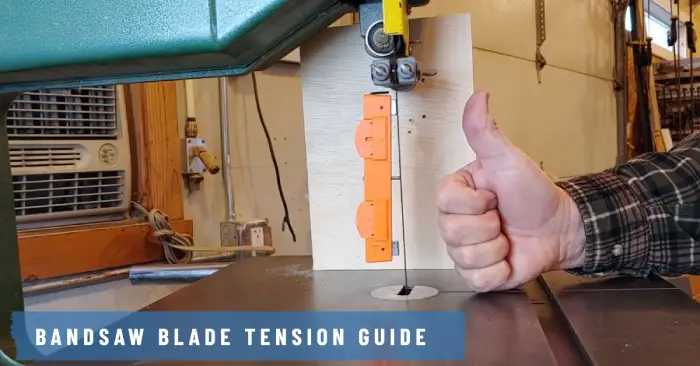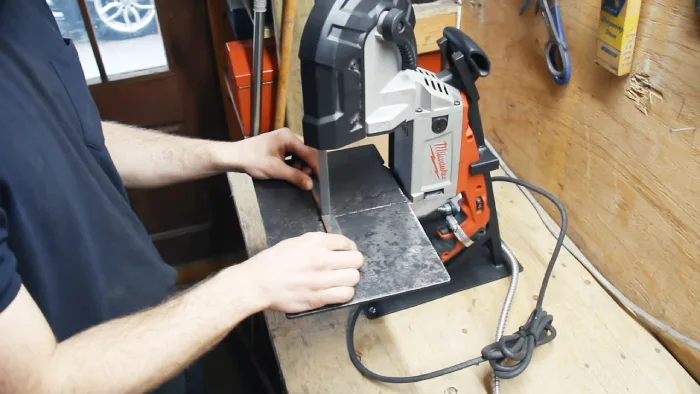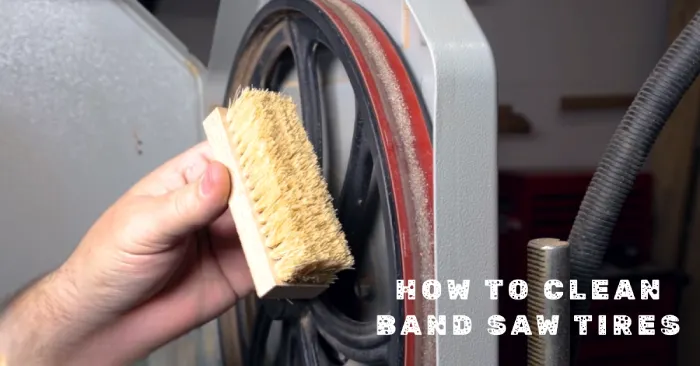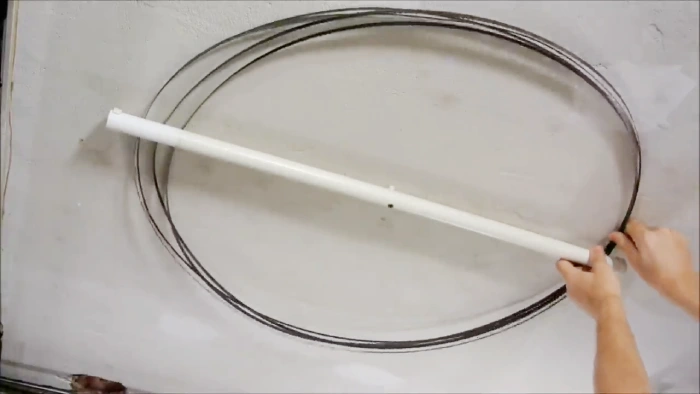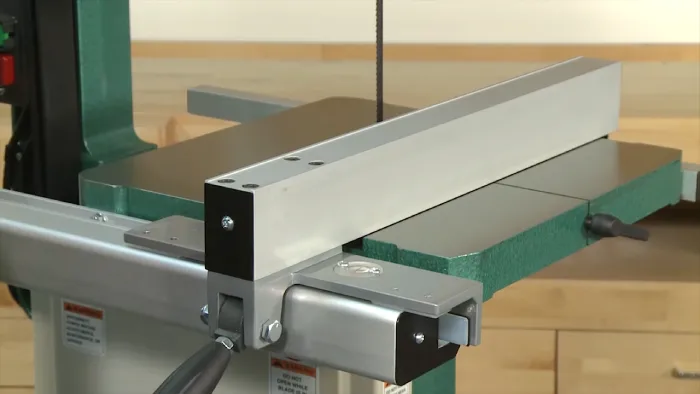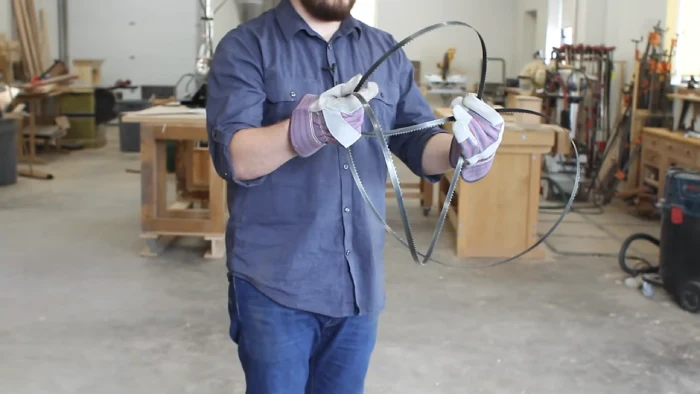Bandsaw Blade Tension Guide: 5 DIY Steps
Bandsaw blade tension is a critical factor in achieving precise cuts, ensuring safety, and prolonging the life of your bandsaw. Without an appropriate tension, the risk of premature blade breakage drastically increases. So, I have extensively researched online to understand how to tension a bandsaw blade for optimal performance.
Power off and unplug the bandsaw to maintain the correct tension PSI on your bandsaw blade. After that, evaluate the current blade tension by checking the deflection and measuring the PSI. Adjust the tension as needed using the tensioning knob or other adjustment mechanisms.
I will discuss the crucial steps of bandsaw blade tension adjustment as part of this discussion. So, keep reading to find the secrets of achieving optimal performance, reducing tracking issues, and improving blade longevity and cost-efficiency.
Bandsaw Blade Tension Guide: How to Maintain the Correct PSI?
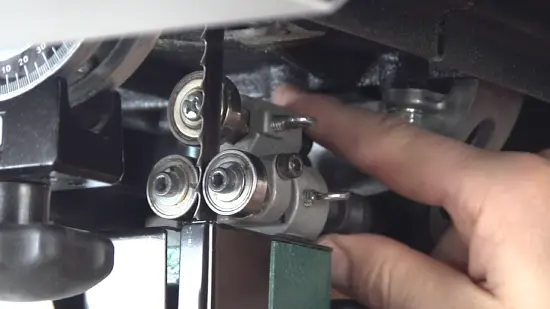
Maintaining the correct pounds per square inch (PSI) of tension is essential for different blades and cutting applications. To maintain the correct PSI on your bandsaw blade, follow the steps I have outlined:
- Power off and unplug the bandsaw
- Evaluate the current blade tension
- Adjust the tension as needed
- Test the new blade adjustment
- Re-tension the blade (if needed)
Step 1: Power Off and Unplug the Bandsaw
Before you begin any adjustments, I suggest turning off and unplugging your bandsaw. This is crucial to prevent accidental starts or injuries while working on the machine.
Unplug the power cord from the electrical outlet to disconnect the bandsaw completely from the power source. Simply turning off the power switch may not be sufficient, as residual electrical current could still flow through the machine.
Step 2: Evaluate the Current Blade Tension
Assess the current tension of the bandsaw blade by using a combination square to gauge side-to-side deflection and check for any visible issues. Ensure the blade is properly centered on the wheels, and examine it closely for any signs of damage or wear.
When testing the tension, gently press your finger against the metal cord and feel for the right amount of flexibility, similar to a well-tuned guitar string. The ideal tension is achieved when the bandsaw blade has some give but isn’t too loose. You should be able to deflect it slightly, approximately 1/4 inch or less.
Step 3: Adjust the Tension as Needed
To begin, set a target deflection for the blade. For precise cuts, aim for approximately an eighth of an inch deflection.
Use the tensioning knob to apply tension to the blade gradually. Start by tightening the knob and check the deflection at specific intervals, such as 3/8 inch for a 3/8 inch blade.
Make adjustments as necessary to achieve the desired deflection. Fine-tune the tension by checking the deflection and employing the pluck test. Repeat this process until the tension feels right.
Step 4: Test the New Blade Adjustment
To ensure the accuracy and effectiveness of your blade adjustment, test the new tension setting by evaluating the quality of the cut. This is crucial because the ultimate indicator of proper tension is the quality of the cut during use. Adjust the tension until you achieve the desired cut results.
Different blades require different tension levels. A tension range of 15,000-20,000 PSI is recommended for common carbon-steel blades, while bimetal, spring-steel, and carbide-tipped blades require a tension range of 25,000-30,000 PSI.
Remember to use tension meters for accurate readings, as tension scales on bandsaws can be inaccurate.
Step 5: Re-Tension the Blade (If Needed)
To ensure the tension of the bandsaw blade is maintained at the correct PSI, re-tension the blade if needed, following the previous step of testing the blade adjustment.
After making a few cuts on scrap wood to test the blade tension, carefully observe the cuts. If the blade is too loose, you’ll notice uneven and jagged cuts, indicating that the blade isn’t staying in place. On the other hand, if the blade is too tight, it may break or wear out more quickly.
Why Bandsaw Blade Tension Matters for Woodworking?
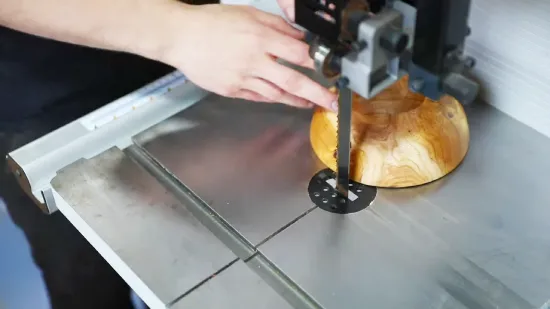
Proper bandsaw blade tension is crucial for woodworking because it ensures blade stability, resulting in consistent cuts. When the bandsaw blade is tensioned correctly, it prevents premature wear and tear, prolonging its lifespan. The following are some key reasons I’ve found about blade tensioning:
Blade Stability and Consistent Cuts
Achieving consistent, straight cuts in woodworking relies heavily on the proper tension of the bandsaw blade. Adequate tension ensures the blade remains firmly in place, reducing the chances of wobbling or wandering off course.
This stability is particularly crucial when working with dense or challenging materials. When properly tensioned, the blade remains taut and straight, enabling precise and accurate cuts.
Prevention of Premature Wear and Tear
Ensuring the appropriate stiffness of the bandsaw blade is crucial for preventing premature wear and tear in both the blade and the bandsaw itself. Overlooking blade tension can lead to detrimental consequences.
When the tension is too low, the blade experiences excessive friction and heat, accelerating its deterioration. This can result in a shorter lifespan for the blade and the bandsaw components.
In contrast, proper tension distribution allows for even load distribution, minimizing wear and tear. Maintaining the correct tension can promote a longer lifespan for your bandsaw blade and ensure consistent and quality cuts.
Neglecting blade tension can lead to expensive repairs and replacements, making it essential to pay attention to this aspect of woodworking.
Minimization of Heat Buildup
To minimize heat buildup during woodworking, maintain the appropriate tension of the bandsaw blade. Incorrect tension can result in excessive friction, leading to increased heat generation during cutting.
This, in turn, accelerates the deterioration of the blade and can have detrimental effects on the material being cut. Ensuring optimal tension can minimize the heat generated, preserving both the blade and the workpiece.
When the blade tension is too low, the blade may deflect, causing it to rub against the material generating excessive heat. Conversely, the blade can become strained if the tension is too high, leading to increased friction and heat buildup.
Risk Mitigation for Blade Breakage
Maintaining the appropriate tension of the bandsaw blade is crucial in mitigating the risk of blade breakage and ensuring safe woodworking operations.
Excessive tension poses a serious threat as it can lead to blade breakage, especially at the weld. When the tension exceeds the recommended levels, the blade becomes susceptible to fractures, potentially compromising the operator’s safety.
Adhere to the correct tension guidelines to mitigate the risk of sudden and hazardous blade failures. By carefully adjusting the tension to the manufacturer’s specifications, blade breakage is minimized, and woodworking is more efficient.
Optimal Performance in Different Applications
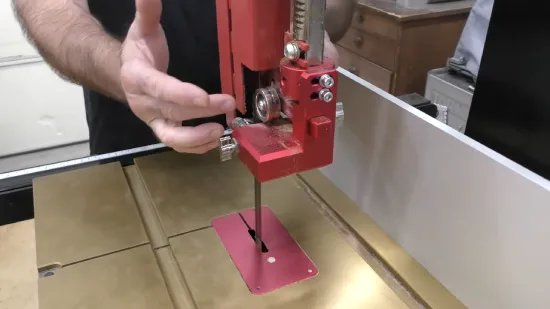
A higher blade tension is necessary when performing intricate and detailed cuts, such as those required for scrollwork or delicate joinery. This helps maintain blade stability, allowing for precise and controlled cuts.
On the other hand, when resawing thick stock, a lower blade tension is recommended. This allows the blade to flex and follow the contours of the wood, resulting in smoother cuts and reduced strain on the blade.
Reduction of Tracking Issues
Proper bandsaw blade tension is essential for minimizing tracking issues and ensuring accurate and precise cuts in woodworking applications. Insufficient tension can lead to tracking issues during cuts, as the entire body of the bandsaw may flex, causing the blade to deviate from its intended path.
This compromises the accuracy of your cuts and introduces the risk of damage to the bandsaw’s tracking system.
Improved Blade Longevity and Cost-Efficiency
Proper bandsaw blade tension is necessary to ensure accurate and precise cuts while minimizing tracking issues in woodworking applications. Beyond preventing premature wear, maintaining optimal tension promotes cost-efficiency by extending the life of your bandsaw blades.
By carefully adjusting the tension, you can reduce the risk of blade breakage and premature dulling, allowing for longer periods of use before replacement. This not only saves money but also reduces downtime.
What can happen if too much tension is applied to a band saw blade?
When too much tension is given to a band saw blade, it can harm its structural integrity. The result is an increased risk of blade breakage and potential snapping, which can be hazardous and cause significant damage.
Excessive tension causes the blade to become overly stressed, leading to the formation of tiny hairline cracks. These cracks weaken the blade, making it more prone to breakage, especially during high-stress cutting operations.
Moreover, if the tension is significantly beyond the blade’s recommended limits, it may snap instantly, posing a serious safety hazard to the operator and those nearby.
Maximize Cutting Efficiency and Safety: Maintain Proper Bandsaw Blade Tension
Maintaining the correct tension on a bandsaw blade ensures accurate and efficient cutting. From ensuring stability and consistency in cuts to preventing premature wear and safeguarding against potential hazards, maintaining the correct tension is a cornerstone of successful woodworking.
Interestingly, studies have shown that maintaining the correct blade tension can increase the blade’s lifespan by up to 30%, saving woodworkers time and money by avoiding frequent replacements. But remember, applying too much tension can lead to blade breakage and premature wear.
Understanding those reasons allows woodworkers to elevate their craftsmanship and create safer, more efficient workspaces.

